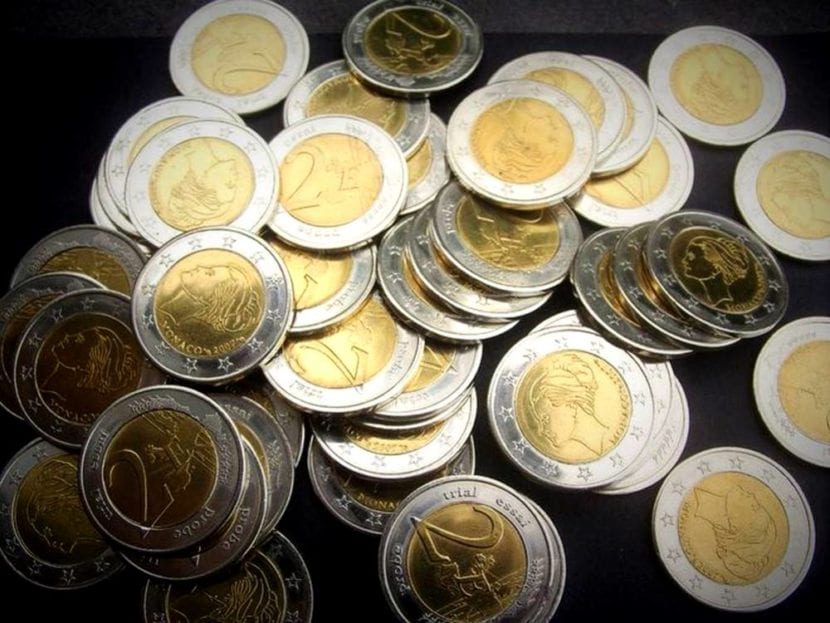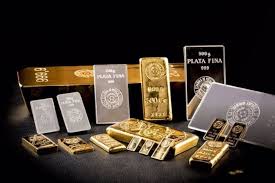The collection of objects has always been one of the hobbies par excellence, but also a business that can generate great income among people with more experience in the field. Within this world, one of the activities that stands out the most among the others is the commemorative coin collection, some of which have been priced in millions of dollars.
Of course There are not many coins that can achieve such value, but there is no doubt that they make up a great market.. One of the most striking examples in this regard is the case of Two euro commemorative coins.
What are two euro commemorative coins?
These coins have been minted since 2004 and are characterized by the fact that one of the faces of said coins is replaced by a commemorative reason, thus celebrating, important moments in the history of that country or of the European Union.
The coins are two euros and are legal tender in all member countries of the eurozone. The first commemorative coin was issued by Greece, on the occasion of the 2004 Athens Olympic Games.
Of course, these coins are special editions for a limited time, so they do not stay on the market for long, reason enough to increase their value exponentially over time.
Until December 31, 2017, a total of 295 commemorative two-euro coins have been minted.
Each Member State of the European Union can mint its own commemorative two-euro coin, however, currently, the maximum number of commemorative coins that each country can issue is a maximum of two coins per year, or three in the event that a compilation This topic is presented with the European Union, which is carried out in order to celebrate anniversaries of special relevance for this political community, this exception being presented only four times to date (2007, 2009, 2012 and 2015).
As a general structure of all the coins that are minted have a common motif on the national side, same in which the name of the issuing country appears.
Likewise, the symbol of the event to be commemorated is also displayed, in the respective language or languages. It should be noted that, unlike what arises with banknotes, euro coins remain the responsibility of each country and not of the European Central Bank.
Two euro commemorative coins in Spain
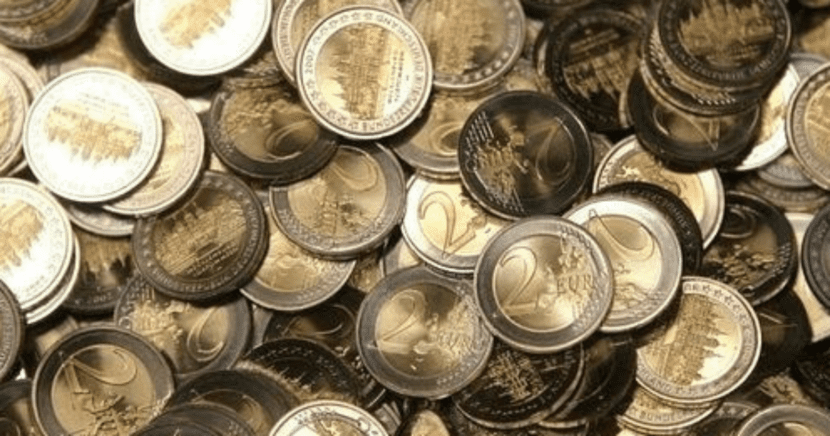
One year after its launch l1st commemorative edition of the two euro coin in Greece, the first commemorative version of this coin was launched in Spain, on the occasion of the IV Centenary of the first edition of "The ingenious hidalgo Don Quixote de la Mancha".
Since then and until today, a total of 16 commemorative two-euro coins in Spain, which have served as a special reminder of anniversaries around events of special significance in the history of Spain.
Below we can see the different editions that have been issued in the country since its first version, which was created in 2005.
a.- 4th centenary of the first edition of Miguel de Cervantes's work "The ingenious hidalgo Don Quixote de la Mancha".
This coin was launched in 2005 with a total issue of eight million units.
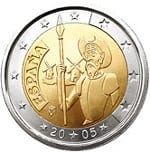
2.- 50th anniversary of the Treaty of Rome.
This coin in turn served as the first commemorative coin in joint issuance with the rest of the countries of the European Union, thus celebrating an important date in common for all its members. It was launched in 2007 and has had an issue of eight million coins in Spain.
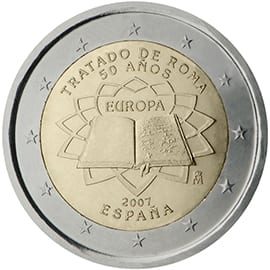
3.- X Anniversary of the Economic and Monetary Union.
This was the second coin issued jointly between the countries of the European Union, just two years after the coin for the anniversary of the Treaty of Rome. It was launched in 2009 with an issue of eight million coins in Spain.
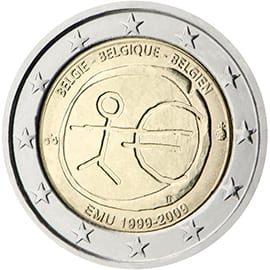
4.- World Heritage Site - Historic Center of Córdoba.
This was the second currency created especially for Spain. It was minted in 2010 with an issue of four million copies.

5.- World Heritage Site - Patio de los Leones de Granada.
Just one year later, the next two-euro commemorative coin was minted for Spain, in 2011, with an issue of four million coins.

6.- World Heritage Site - Burgos Cathedral.
The next commemorative coin for Spain was launched in 2012, the same with an issue of four million coins.
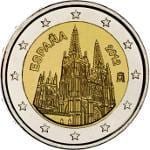
7.- Ten years of the Euro.
On the occasion of this celebration, in 2012 two commemorative two-euro coins were minted in Spain for the first time. This version corresponds to the third coin that was launched together with the European Union.
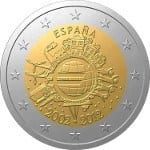
8.- World Heritage Site - San Lorenzo del Escorial Monastery.
A year later, in 2013, another coin was minted for Spain, with the usual issue of four million copies.
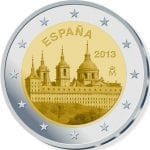
9.- World Heritage Site - Park Güell.
The following year, in 2014, a new commemorative coin was minted for Spain, but this time, with an issue of 8,100,000 coins.
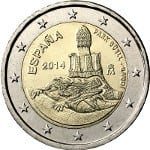
10.- Proclamation of His Majesty King Felipe VI.
It was minted in 2014 and has had an issue of 8, 100,000 coins.
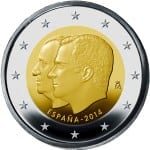
11.- World Heritage Site - Altamira Cave.
This coin. Two commemorative coins were reissued in 2015. It corresponds to the one I minted for Spain with an issue of 4,200,000 coins.
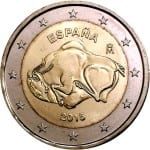
12.- XXX Anniversary of the European Flag.
With an issue of 4,300,000 coins, this coin that was also launched in 2015 corresponds to the last issue in conjunction with the countries of the European Union.
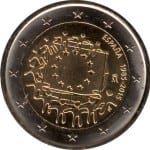
13.- World Heritage Site - Aqueduct of Segovia.
This coin was minted in 2016 and was presented with an issue of 3,400,000 coins.

14.- World Heritage Site - Church of Santa María del Naranjo.
For the celebration of this event, only 500,000 coins were produced in 2017, making this version one of the rarest.
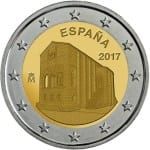
15.- World Heritage Site - Old Town of Santiago de Compostela.
With 300,000 copies this year, this coin is the rarest two-euro commemorative coin ever issued by Spain.
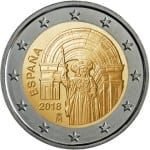
16.- 50th Anniversary of King Felipe VI.
It is the last commemorative coin minted to date in Spanish territory, and it is also one of the rarest since it barely has 400,000 copies.
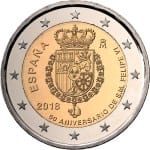
Eurozone commemorative coins issued jointly
To date, a total of four commemorative coins have been issued jointly by the member countries of the European Union, which have been released on the following dates:
2007 joint issue currency
The first commemorative version as a whole was launched in March 2007, on the occasion of the fiftieth anniversary of the Treaty of Rome. As is well known, the Treaty of Rome is how the two treaties that gave rise to the training of the European Union in 1957 are known. The first member countries of this political community were the countries of Federal Germany, Belgium, France, Luxembourg , Italy and the Netherlands. These first six members constitute the fundamental basis of what would later become a large geopolitical entity with a total of 28 adhering member states.
As a consequence, the engraving of this coin shows the 6 signatures of the founding states of the Treaty of Rome. In the background you can see a design inspired by the pavement of the Piazza del Campidoglio in Rome. Because this currency corresponds to the countries of the Eurozone, the model may vary in the name and language of the country where it is issued. As an additional detail, the outer ring of the coin features the twelve stars of the European Union.
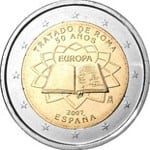
2009 joint issue currency
This coin was issued as part of the 10th anniversary of the European Monetary Union, which was where the euro emerged as the community's reference currency and the European Central Bank was established.
In the design of this coin you can see a human figure located in the center, and whose left arm is extended by the euro symbol. The twelve stars of the European Union can be seen surrounding the design of the outer circular crown of the coin.
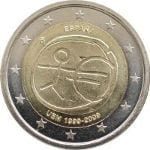
Coin issued jointly in 2012
This model was issued to celebrate the 10th anniversary of the circulation of euro coins and bills. Its design was chosen in a vote, where the winner would be issued in all the countries of the euro zone.
With this design it was sought to celebrate and symbolize the way in which the euro has become a true global actor as it is an essential part of the daily life of European citizens and of their various economic activities, which is why it was sought to represent the currency. such as family, commerce, industry, and energy, through images such as members of a family, a ship, a factory, and wind power plants.
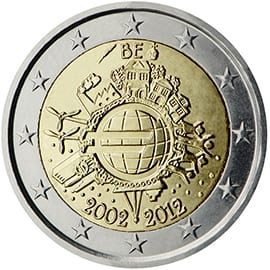
Coin issued jointly in 2015
The fourth coin of joint issue was launched as a reason for the 30th anniversary of the European Union and with this it was sought to represent the flag as a symbol of the joint vision of the ideals and culture of the European peoples in their aspiration for a better future.
From this dynamic, in the circular crown of the coin you can see the twelve stars of the European Union, which represent the ideals of unity, solidarity and harmony among the peoples of Europe.
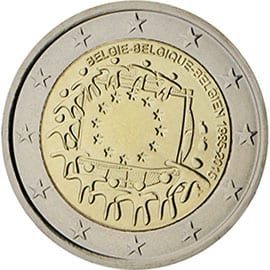
We can say…
The two euro commemorative coins are a precious collector's item. They have a high market value that rises day by day, so it is highly recommended to take advantage of the possibility that presents itself when a new version of this coin is launched on the occasion of the anniversary of an important event.
Yes it's him commemorative coins of Spain or those that have been launched jointly with the European Union, These are very valuable and precious objects not only for coin collectors, but also for anyone who feels identified with their culture and with the nations that make up the rest of the European continent, because over the years, these countries they have been able to find a unity and an identification that can hardly be emulated in other parts of the world.

